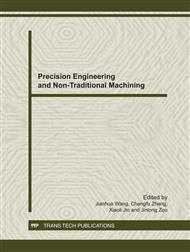[1]
LV Xuewen, KAO Hongtao, Progress in Composite Phase Change Energy Storage Materials[J], Journal of Materials Science & Engineering, No.(5),Vol.(28), 2000:797-799.
Google Scholar
[2]
ZENG Lingke, LIU Yanchun and SONG Jing etc, Regenerative Energy Storage Phase Change Composite and Its Progress[J], Materials Research & Application, No.(4),Vol.(2),2008:98-100. (In Chinese)
Google Scholar
[3]
Krupa, G. Mikova, A. S. Luyt, Polypropylene as a potential matrix for the creation of shape stabilized phase change materials [J], European Polymer Journal, 2007, 43: 895-907.
DOI: 10.1016/j.eurpolymj.2006.12.019
Google Scholar
[4]
Cao Y, Faghri A, A study of thermal energy storage systems with conjugate turbulent forced convection [J]. Journal of Heat Transfer, 1992, (114): 101-1027.
DOI: 10.1115/1.2911872
Google Scholar
[5]
ZHANG Jusong,JIN ling,WU Xiaodan, Development of Phase Change Materials and Application in Building Energy Saving[J], Liaoning Building Materials,Vol.(2),2010:38-41.
Google Scholar
[6]
JIANG Congcong, GAO Zidong and LI Guozhong, Study on Composite Phase Change Material in the Energy-conservation[J],Wall, Brick and Tile, Vol.(12),2000:10-12.
Google Scholar
[7]
ZHONG Kaihong, Review of the Application of Changing Energy-storing Material on Building Energy Saving [J], Guangzhou Architecture, 2006, Vol. (2):37-39.
Google Scholar
[8]
Zhang Zhengguo, Fang Xiaoming, Study on Paraffin/ expanded graphite composite phase change thermal energy storage material [J], Energy Conversion and Management, (47), 2006:303~310.
DOI: 10.1016/j.enconman.2005.03.004
Google Scholar
[9]
Michio INAGAKI,Tomoya NAGATA, Sorption kinetics of various oils onto exfoliated graphite[J].New Carbon Materials.2006.21(2):97-101.
Google Scholar
[10]
Hawes D W, Feldman D. Absorption of Phase Change Materials in Concrete [J]. Solar Energy Materials and Solar Cells, 1992, 27(2):91-101.
DOI: 10.1016/0927-0248(92)90112-3
Google Scholar
[11]
Hasan A, Phase Change Material Energy Storage System Employing Palmitic Acid [J], Solar Energy 1994, 52:143-146.
DOI: 10.1016/0038-092x(94)90064-7
Google Scholar
[12]
Karaipek li A, Sari A, Kaygusuz K, et al, Thermal conductivity improvement of stearic acid using expanded graphite and carb on fiber for energy storage applications [J],Renewable Energy, 2007,32:220~ 221.
DOI: 10.1016/j.renene.2006.11.011
Google Scholar


